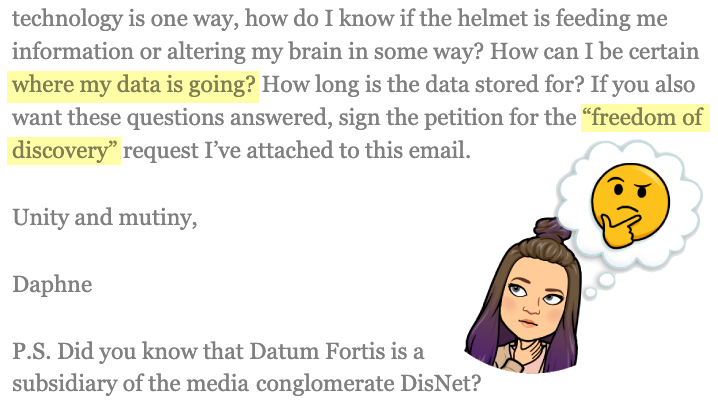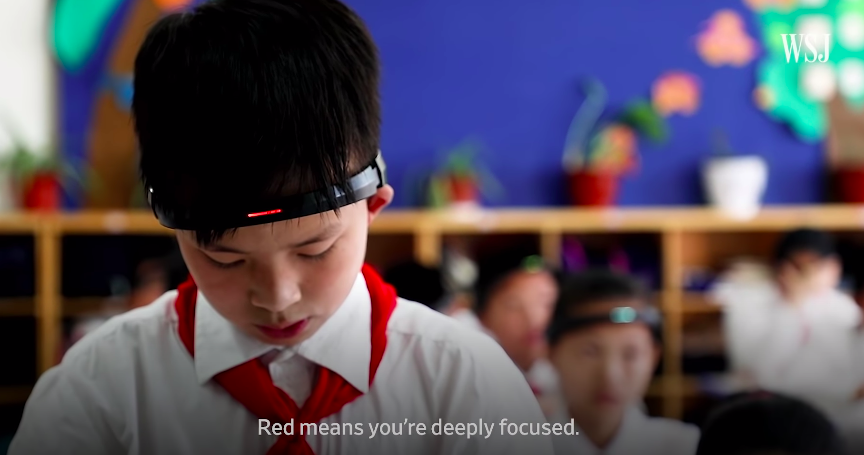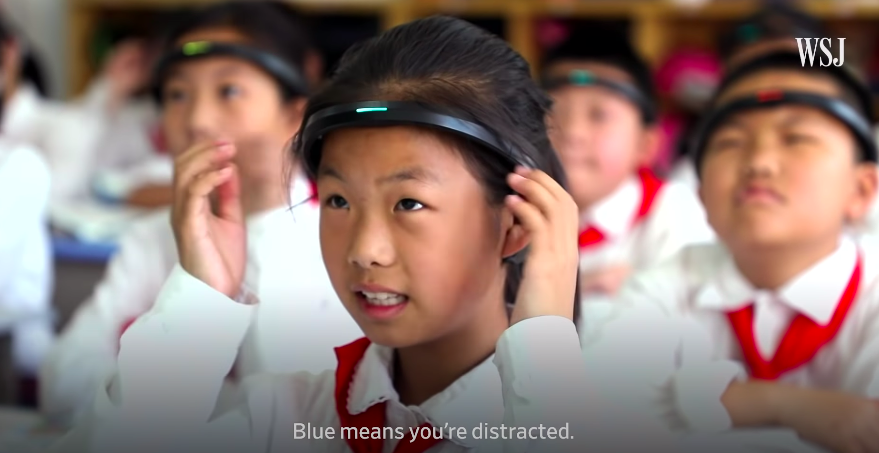 Link to Deirdre’s entry: https://blogs.ubc.ca/ideamachinery/2021/04/02/task-12-speculative-futures/
Link to Deirdre’s entry: https://blogs.ubc.ca/ideamachinery/2021/04/02/task-12-speculative-futures/
Deirdre’s speculative futures are among my favourites I’ve browsed through. Both of them completely lean into the world she created, each narrative seemingly just ‘plucked’ from that existing story. I’ve chosen to focus on her first speculative future.
The first narrative centres around the idea of data collection from students. In the narrative, a student sends out a concerned email about the Harvest Helmets they have to wear for school. Interestingly the school’s motto, “Gather, manage, monitor,” may seem dystopian but I can see echoes of this behaviour when teachers are asked to facilitate the FSA’s and Learning Surveys, where students input their knowledge and the results are coded to individual Personal Education Numbers. However, it seems like the world this student lives in has taken this to an extreme, when she suspects that even private details like when she uses the washroom, when she has her period, and what websites she uses are being tracked by the helmets.
It does seem like Deirdre’s speculative future is not-too-far in the future.
A primary school in China tested out unique headband devices where students’ brainwaves are monitored. Zhang, one of the teachers at the school, justifies the use of these devices: “All we are doing is providing some assistance for the students to see how much they are paying attention. Because the data is transferred to the teacher, the students will concentrate more than usual, and we’ve indeed seen some improvements” (Tai, 2019, Guardian). Not even parents have access to the data, only teachers, who allegedly only use the averages in the class to make improvements towards their own lessons. These trials were eventually stopped by the government due to privacy concerns and media pressure.



Screenshots from WSJ: How China Is Using Artificial Intelligence in Classrooms
Deirdre’s Harvest Helmets are much more sophisticated (e.g., measures grip strength to examine anxiety levels). It’s interesting that she has created Datum Fortis as the for-profit educational technology company behind these helmets. Similar to my SUB SPECS, it seems like we cannot get away from money and power being powerful players driving these technological advancements.
Deirdre’s use of this sinister dystopian setting echoes Dunne & Raby’s (2013) assertion that “darkness as an antidote to naive techno-utopianism can jolt people into action” (p. 38). In the Wall Street Journal video, it is suggested that there was probably no privacy protocols these headbands were adhering to and yet some interviewed parents were not concerned where the data was going. Some students joked that it felt like they were being controlled. One student mentioned how the headband helped him concentrate and his assignments were now returned with perfect scores, while another student complained that he was getting punished at home for low attention scores (the headband snitched!).
It feels surreal watching these interviews, and it makes me wonder if there would’ve been any students who would’ve organized a petition for “freedom to discovery,” like in Deirdre’s narrative. The Orwellian tone of the email encourages the reader to consider why we feel this invasion of privacy is wrong, and if there is anything currently that mirrors this hyperbolic world Deirdre has created. In this moment where we try to set ourselves apart from this seemingly crazy world by affirming how different our current technology practices are, we move from complacency to critical thinking. This is precisely why speculative futures are important and useful exercises.
References
Dunne, A. & Raby, F. (2013). Speculative Everything: Design, Fiction, and Social Dreaming. Cambridge: The MIT Press.
Standaert, M. (2019, November 1). Chinese primary school halts trial of device that monitors pupils’ brainwaves. The Guardian. https://www.theguardian.com/world/2019/nov/01/chinese-primary-school-halts-trial-of-device-that-monitors-pupils-brainwaves
Tai, C. [Wall Street Journal]. (2019, October 1). How China Is Using Artificial Intelligence in Classrooms | WSJ [Video]. YouTube. https://www.youtube.com/watch?v=JMLsHI8aV0g